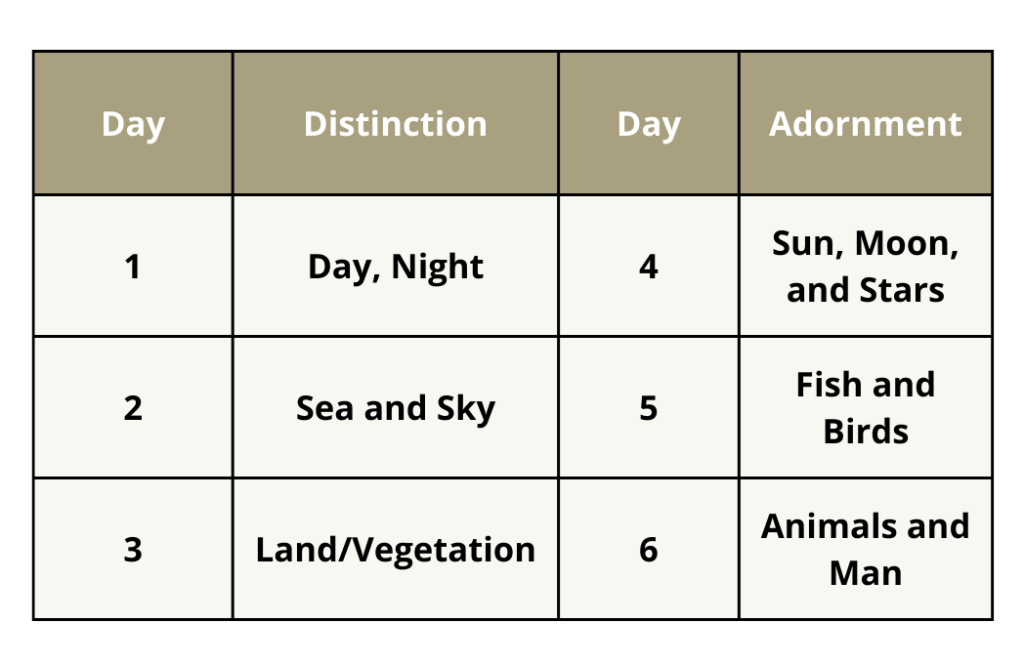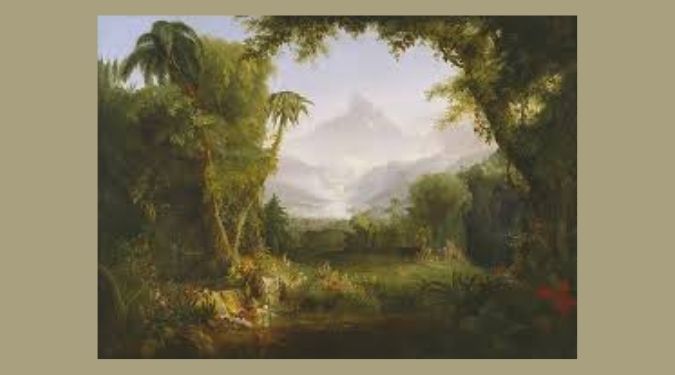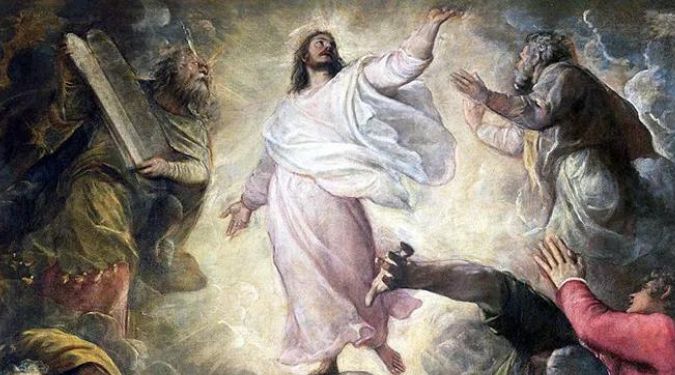Introduction
St. Thomas Aquinas has provided the Church with an intriguing interpretation of the six days of creation described in the first chapter of the Book of Genesis.
The Six Days
You undoubtedly remember the story of creation in the Book of Genesis:
- On day one, God created the light and separated it from the darkness, calling them Day and Night;
- on day two He created the expanse of the sky, separating the waters on earth from the waters above;
- on day three He separated the sea and the land, and caused vegetation to grow on the land;
- on day four He created the sun, moon, and the stars;
- on day five He created living creatures to inhabit the air and in the sea; and
- on day six, God created living creatures on the land, and man.
A Problem
One problem can be seen right away: day and night are created on day one, but the sun is not created until day four. Could the sacred human author and his audience be unaware that the sun causes daylight? It would be arrogant of us to think so. But what are we to make of this?
Empty and Void
Let’s start with the first two verses:
In the beginning, God created the heavens and the earth. The earth was without form and void, and darkness was over the face of the deep.
Genesis 1:1-2 ESV
The phrase “without form and void” in English translates the Hebrew phrase וָבֹ֔הוּ תֹ֙הוּ֙, memorably pronounced, “TOE-hoo wa-BOE-hoo”.
Distinction and Adornment
In his Summa Theologiae, St. Thomas Aquinas describes God’s work in curing the formlessness and emptiness by operations he categorizes as “distinction” and “adornment”. “Distinction” might be a philosophical word of art, but for our purposes, God is creating distinct features of creation. By “adornment” St. Thomas means the populating of the distinct forms with creatures, both inanimate and living.
Here’s a quotation from the first part of the Summa, in an answer to question 70:
…that three things are recorded as created, namely, the heaven, the water, and the earth; and these three received their form from the three days’ work of distinction, so that heaven was formed on the first day; on the second day the waters were separated; and on the third day, the earth was divided into sea and dry land. So also is it in the work of adornment; on the first day of this work, which is the fourth of creation, are produced the lights, to adorn the heaven by their movements; on the second day, which is the fifth, birds and fishes are called into being, to make beautiful the intermediate element, for they move in air and water, which are here taken as one; while on the third day, which is the sixth, animals are brought forth, to move upon the earth and adorn it.
St. Thomas Aquinas, Summa Theologiae, First Part, Question 70
There is a pattern or framework here. According to St. Thomas, the work of distinction takes place on days one through three. The inspired author of Genesis uses the words “separating”, or “dividing” and “gathering” when describing the work of those days.
The adornment of those forms takes place on days four through six, so forming three pairs of days: one and four, two and five, and three and six. That is, on day one, night and day are made, and on day four, day and night are adorned with the sun, moon, and stars. On day two, the sea and sky are made distinct by separating the waters above and below, and on day five, the sea and sky are adorned with creatures. And on day three, the land is made distinct from the sea and on day six the land is adorned with living creatures and with man.
The pattern that St. Thomas describes is often called the framework interpretation of the six days of creation. The problem I mentioned earlier, that the sun was not created until day four, is now explained by this non-chronological interpretation of the creation story.

St. Augustine’s “day”
Now what about the whole notion of “a day”? Drawing upon St. Augustine, St. Thomas says,
If, however, we take these days to denote merely sequence in the natural order, as Augustine holds (Gen. ad lit. iv, 22,24), and not succession in time, there is then nothing to prevent our saying, whilst holding any one of the opinions given above, that the substantial formation of the firmament belongs to the second day.
St. Thomas Aquinas, Summa Theologiae, First Part, Question 68
A bit later in the Summa he adds:
For Augustine understands by the word “day,” the knowledge in the mind of the angels, and hence, according to him, the first day denotes their knowledge of the first of the Divine works, the second day their knowledge of the second work, and similarly with the rest…So the distinction of days denotes the natural order of things known, and not a succession in the knowledge acquired, or in the things produced.
St. Thomas Aquinas, Summa Theologiae, First Part, Question 74
In other words, “a day” refers to angelic knowledge of a specific work of God, and not to a unit of time as we know it.
Conclusion
The first chapter of Genesis tells us no less than seven times that God saw that his distinction and adornment was good. St. Thomas says,
“And the words ‘God saw that it was good,’ signify that the things that He had made were to endure, since they express a certain satisfaction taken by God in His works, as of an artist in his art”
St. Thomas Aquinas, Summa Theologiae, First Part, Question 74
To St. Thomas, God is an artist.
Let’s finish with some words on this from the Catechism, section 337:
God himself created the visible world in all its richness, diversity and order. Scripture presents the work of the Creator symbolically as a succession of six days of divine “work”, concluded by the “rest” of the seventh day. On the subject of creation, the sacred text teaches the truths revealed by God for our salvation, permitting us to “recognize the inner nature, the value and the ordering of the whole of creation to the praise of God.”
Catechism of the Catholic Church, 337







The Theological insight of St Augustine and St Thomas of Aquinas on the six days of creation is totally awesome and very deep.
What I can’t understand is on the 7th day God rested. If every “day” supposedly took say thousands/millions of years to actually happen, that would mean the 7th day also lasted thousands/millions of years. So, at what point in history does man actually declare a “day” 24 hours long? Did not God declare that when he stated “there was evening and there was morning, one day, ….there was evening and there was morning, a second day,…..there was evening and there was morning, a third day…..etc. ?
I am glad the church allows us to believe that the world was created in 6 actual 24hr days. Can God do this? Well, of course He can. Did He? We’ll eventually find out for sure. Does this belief, one way or the other, determine our salvation? No. God Bless
You’ll notice that I only drew upon the opinions of St. Augustine and St. Thomas Aquinas in this post. I think their perspective offers the faithful a great alternative to an overly literalist interpretation.